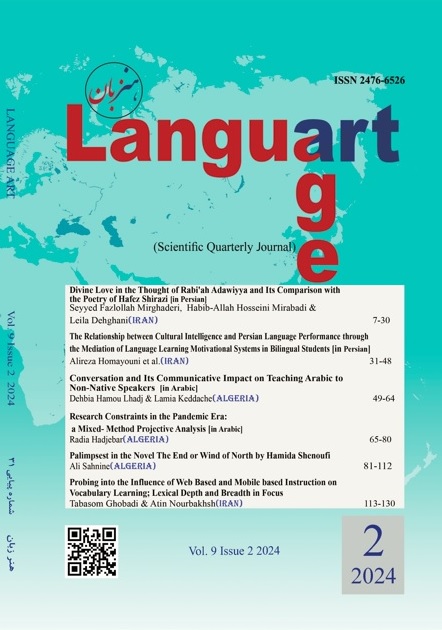Conversation and Its Communicative Impact on Teaching Arabic to Non-Native Speakers
DOI:
https://doi.org/10.22046/LA.2024.09%20Keywords:
Conversation, Communication, Language Teaching, Sequence Method, Language AcquisitionAbstract
Oral conversational language education offers a distinctive opportunity for language acquisition and learning, giving the learner value and meaning to language learning, and the skills acquired are more visible, allowing him to employ the language acquired in multiple situations. It seems through experiments that the learner in this way is more positive and involved in formal linguistic practice As it has the ability to express and write den hindrances and desires to learn the second language, Which is done only by immersing itself in the surroundings of that language. Learning", the learner employs his or her linguistic asset through language communication and training in the construction of new language compositions produced spontaneously without making or costing, as it tries to employ language elements to create real linguistic communication appropriate to the social, linguistic and cultural context during linguistic and conversational practice. This topic seeks to determine the place of conversation in teaching Arabic to non-speakers, and to monitor the most important strategy for the success of the method of dialogue and conversation by referring to the role of expression and archives, and standing in the techniques followed and the way of F. Joan Gouin François is a model, and this is by tracking the analytical descriptive curriculum that allows to stand up to the conversation mechanism and reveal its importance in teaching Arabic to non-speakers. One of the outcomes we want is to focus on the continuum in Arabic language education, adopt the conversation as a way of teaching as its design and objectives approach real attitudes and drive the learner into practice by respecting the language's norms and synthesis, and create other methods aimed at consolidating the second language in particular.
References
نايف خرما، علي حجاج (1998). اللّغات الأجنبية تعليمها وتعلّمها، ط1، المجلس الوطني للثّقافة والفنون والآداب، الكويت.
دوجلاس براون (1994). أسس تعلّم اللّغة وتعليمها، ترجمة عبده الرّاجحي وعلي علي أحمد شعبان، د.ط، دار النّهضة العربية للطّباعة والنّشر، بيروت.
رمزي مفتاح (1963). التّعليم بحث تمهيدي، دار الفكر العربي، القاهرة.
أحمد عبده عوض (2000). مداخل تعليم اللّغة العربية، دراسة مسحية نقدية، ط1، جامعة أم القرى، مكة المكرّمة.
محمد علي حافظ (1984). التّخطيط للتّربية والتّعليم، الدّار المصرية للتّأليف والتّرجمة، القاهرة.
سميح أبو مغلي (1997). الأساليب الحديثة لتدريس اللغة العربية، ط1، دار الفكر للطباعة والنشر والتوزيع، الأردن.
رشدي أحمد طعيمة (2004). المهارات اللّغوية، مستوياتها، تدريسها، صعوباتها، ط1، دار الفكر العربي، القاهرة،
عبد الرحمان ابن خلدون (2004). المقدمة، (ديوان المبتدأ والخبر في تاريخ العرب والبربر ومن عاصرهم من ذوي الشأن الأكبر)، دار الفكر للطباعة والنشر والتوزيع، بيروت.
عبد العليم إبراهيم (1976). الموجه الفني لمدرسي اللغة العربية، ط9، مطابع دار المعارف، مصر.
عبد الفتاح حسن البجة (2005). أساليب تدريس مهارات اللغة العربية وآدابها، دار الكتاب الجامعي، الإمارات العربية.
صالح بلعيد (2000). دروس في اللسانيات التطبيقية، دار هومة للنشر والتوزيع، الجزائر.
باني، عميري (1981). دراسة نحوية لكتاب المختار في قواعد اللغة العربية المقرر للسنة الأولى من التعليم المتوسط بالمدرسة الجزائرية (دراسة على ضوء اللسانيات التطبيقية)، الجزائر.
عليالجمبلاطي، أبو الفتوح التوانسي (1981). الأصول الحديثة لتدريس اللغة العربية، ط2، دار نهضة مصر للطبع والنّشر، مصر.
نايف معروف (1985). خصائص العربية وطرائق تدريسها، ط1، دار النفائس، بيروت.
Jean Berco-Gleason )1982). Insight from child acquisition for second language loss, in Lambert and Freed.
Cicurel, F. )1998(. «Hétérogénéité des dires dans une situation d’enseignement / apprentissage». In Souchon M. (dir.). Pratiques discursives et acquisition des langues étrangères. Actes du Xe colloque international «Acquisition d’une langue étrangère : perspectives et recherches ». Besançon : Centre de linguistique appliquée de Besançon..
Nāyif khrmā, ʻAlī Ḥajjāj (1998). alllghāt al-ajnabīyah taʻlīmihā wtʻllmhā, ed.1, al-Majlis al-Waṭanī llththqāfh wa-al-Funūn wa-al-Ādāb, al-Kuwayt,.
Dwjlās Brāwn (1994). Usus tʻllm alllghh wtʻlymhā, tarjamat ʻAbduh alrrājḥy wa-ʻAlī ʻAlī Aḥmad Shaʻbān, , Dār alnnhḍh al-ʻArabīyah llṭṭbāʻh wālnnshr, Bayrūt.
Ramzī Miftāḥ (1963). alttʻlym baḥth tamhīdī, Dār al-Fikr al-ʻArabī, al-Qāhirah.
Aḥmad ʻAbduh ʻAwaḍ, (2000). madākhil Taʻlīm alllghh al-ʻArabīyah, dirāsah masḥīyah naqdīyah, ed.1, Jāmiʻat Umm al-Qurá, Makkah almkrrmh.
Ḥamad ʻAlī Ḥāfiẓ (1984). alttkhṭyṭ llttrbyh wālttʻlym, alddār al-Miṣrīyah llttʼlyf wālttrjmh, al-Qāhirah.
Samīḥ Abū Mughlī (1997). al-asālīb al-ḥadīthah li-tadrīs al-lughah al-ʻArabīyah, ed.1, Dār al-Fikr lil-Ṭibāʻah wa-al-Nashr wa-al-Tawzīʻ, al-Urdun.
Rushdī Aḥmad Ṭuʻaymah (2004). al-mahārāt alllghwyh, mstwyāthā, tadrīsihā, ṣʻwbāthā, ed.1, Dār al-Fikr al-ʻArabī, al-Qāhirah.
Abd al-Raḥmān Ibn Khaldūn (2004). al-muqaddimah, (Dīwān al-mubtadaʼ wa-al-khabar fī Tārīkh al-ʻArab wa-al-Barbar wa-man ʻāṣarahum min dhawī al-shaʼn al-akbar), Dār al-Fikr lil-Ṭibāʻah wa-al-Nashr wa-al-Tawzīʻ, Bayrūt.
Abd al-ʻAlīm Ibrāhīm (1976). al-muwajjah al-Fannī lmdrsy al-lughah al-ʻArabīyah, ed.9, Maṭābiʻ Dār al-Maʻārif, Miṣr.
Abd al-Fattāḥ Ḥasan al-Bajjah (2005). Asālīb tadrīs mahārāt al-lughah al-ʻArabīyah wa-ādābihā, Dār al-Kitāb al-Jāmiʻī, al-Imārāt al-ʻArabīyah.
Ṣāliḥ Balʻīd (2000). Durūs fī al-lisānīyāt al-taṭbīqīyah, Dār Hūmah lil-Nashr wa-al-Tawzīʻ, al-Jazāʼir.
Ṣāliḥ Balʻīd (2000). Durūs fī al-lisānīyāt al-taṭbīqīyah, Dār Hūmah lil-Nashr wa-al-Tawzīʻ, al-Jazāʼir.
Bānī, ʻUmayrī (1981). dirāsah naḥwīyah li-kitāb al-Mukhtār fī Qawāʻid al-lughah al-ʻArabīyah al-Muqarrar lil-Sunnah al-ūlá min al-Taʻlīm al-Mutawassiṭ bi-al-Madrasah al-Jazāʼirīyah (dirāsah ʻalá ḍawʼ al-lisānīyāt al-taṭbīqīyah), al-Jazāʼir.
Alī aljmblāṭy, Abū al-Futūḥ altwānsy (1981). al-uṣūl al-ḥadīthah li-tadrīs al-lughah al-ʻArabīyah, ed.2, Dār Nahḍat Miṣr lil-Ṭabʻ wālnnshr, Miṣr.
Nāyif Maʻrūf (1985). Khaṣāʼiṣ al-ʻArabīyah wa-ṭarāʼiq tadrīsihā, ed.1, Dār al-Nafāʼis, Bayrūt.
Downloads
Published
How to Cite
Issue
Section
License
Copyright (c) 2024 ذهبية حمو الحاج

This work is licensed under a Creative Commons Attribution 4.0 International License.

